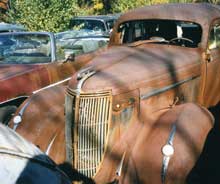Ahead of the Game
Everyone knows that Nash pioneered Unitized construction, in-car beds and "Weather Eye conditioned air" heating and ventilation. Note that it was not called "air conditioning," since there was no compressor to cool the air, but the system was thermostatically controlled and filtered. (How many owners, do you think, changed their filters even once a year?) Some, however, assume all these advances arrived with the new-for-1949 "bathtub" models. Nash Motors deserves more credit than that.
While many 1930s Nash models were typical of the decade (did Babe Ruth own one, or is this merely a photo op?) , the marque had begun the Depression with a line of prestige cars, powered by twin-ignition ohv straight eights. Fresh, new styling for 1939 was reprised in 1940 with a slightly different grille and sealed beam headlights, but Weather Eye was already established in the catalog. Flagship of the 1940 line was the Sakhnoffsky-designed Ambassador Special Cabriolet, of which eleven were built.
For 1941 came Unitized construction on the Ambassador 600 model (its cruising range - 30 mpg on a 20-gallon tank). The 1941 models, in addition to an art moderne horn ring, offered berthing for two, albeit partly in the trunk. The '42s showed hints of styling cues to come post-war. We tend to forget, though, that the "regular" Ambassador Sixes and Eights still had chassis frames. After the war, Cannonball Baker paced Indy with one in 1947 and the final body-on-frame Nash appeared as the 1948 Ambassador.
And lest you think that Nash was slow coming to streamlining, consider the 1935 models, less arresting than Chrysler's Airflow, more in the mode of the 1934-35 Studebakers, albeit with subtler ornamentation. Yes, Nash was farther ahead, in the 1930s and '40s, than most people acknowledge.

